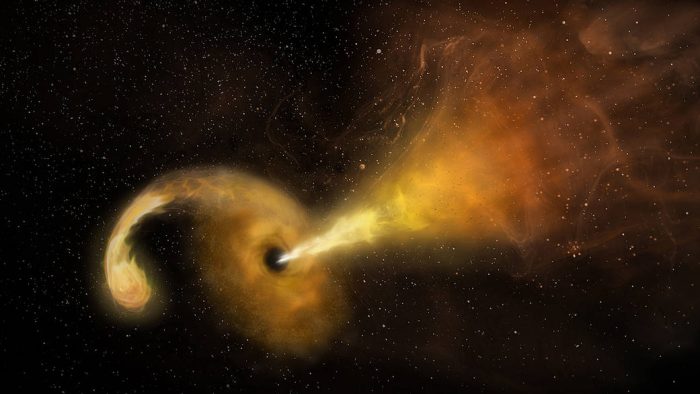May 1 to 16 is Science Odyssey, a celebration of all things science! OWLconnected is recognizing this two-week event with lots of science content, as well as with an amazing contest, presented by our friends at the Natural Sciences and Engineering Research Council of Canada (NSERC). Details are at the end of this post—be sure to enter!
For our final science odyssey post, we're blasting off into deep space ... for a visit to a black hole!
Supermassive star destroyer
Black holes are both a terrifying yet cosmically cool feature of Space. We cannot get enough of them!
Scientists and astronomy fans alike love learning about the cosmic destruction that black holes unleash upon stars and galaxies—especially if we get to watch a simulation from the comfort and safety of Earth.
A particle accelerator lab in Hamburg, Germany (the Deutsches Elektronen-Synchrotron, or DESY) has created a dazzling visual to help us better understand how stars interact with black holes. Spoiler alert: It doesn’t end well for the star.
Watch a black hole tear a star to shreds in this realistic animation:
Cool! But what’s going on?
What we see happening in the video is what scientists call a 'Steller Tidal Disruption'—an event that occurs when a star gets too close to a supermassive black hole. The star is quickly sucked in and gets torn apart by the black hole’s gravitational forces, experiencing a process called 'spaghettification'.
Believe it or not, spaghettification—also sometimes referred to as the “noodle effect”—is the real scientific name for the squashing and stretching caused by black holes and their strong gravitational tidal forces. (For more on what this force does to things, read here!)
“As the star gets closer, this stretching becomes more extreme,” explains Robert Stein, a scientist at DESY. “Eventually, it rips the star apart.”
In the video, we see the star’s outer layer get pulled downwards towards the centre, before spinning around and around and getting 'spaghettified'.
What happens next?

Black holes are always ready to consume whatever comes their way—anyone craving spaghetti all of the sudden? (Sophia Dagnello, NRAO/AUI/NSF)
After the star gets torn apart, most its debris gets flung back into space. Only about 1% of the star's mass actually gets consumed by the black hole’s event horizon—slowly getting sucked in like water circling down a drain in a bathtub. Tiny little particles called neutrinos are also flung from the black hole, eventually passing through (yes, through!) Earth for scientists to observe in labs.
Even though black holes are super cool, this video serves as an excellent reminder to keep our distance from them. Thankfully we don't have any of them around here!
Contest alert
Don't forget to enter the Science Odyssey Contest! Click HERE TO ENTER.

 Nom nom nom! Stars that get too close can quickly become meals for a black hole. (NASA)
Nom nom nom! Stars that get too close can quickly become meals for a black hole. (NASA)










Cool!
Wow that so neat I never new that the black hole was so strong 😮
Wow amazing
Wow! I never saw an animation that good before! 😮 So cool! 😎